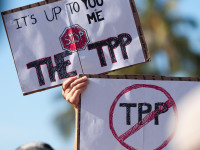The intersection between the TPP and Canadian cultural policies is likely to emerge as one of the more controversial aspects of the TPP, particularly given the government’s emphasis on a stronger cultural policy in its election platform. Earlier in the Trouble with the TPP series, I wrote that the TPP fails to protect Canadian cultural policy. I pointed to U.S. lobby pressure to limit Canadian protection of cultural policies as well as provisions that restrict Canada’s ability to consider expanding Cancon contributions to entities currently exempt from payment. I have not been a supporter of mandating Cancon contributions to online video provides such as Netflix, but restricting Canada’s right to do so in a trade agreement is shortsighted, bad policy.
Peter Grant has written a careful response to my post on Barry Sookman’s blog. He argues that Canada can still “maintain or enhance our cultural policies.” He opens by stating that “I am not entirely wrong” about the TPP being a departure from Canada’s traditional approach to culture in trade agreements. However, he argues that the TPP approach is not unique since the Canada – EU Trade Agreement adopts a similar approach. Yet CETA contains numerous cultural exceptions within the chapters for Cross-Border Trade in Services, Domestic Regulation, Government Procurement, Investment, and Subsidies. In the TPP, there are only seven provisions in the entire agreement that are subject to the cultural exception and many of the issues addressed by CETA are not covered. Further, the TPP has exceptions to the cultural exception not found in CETA and (as Grant notes) Canada did not get an explicit exception to allow for measures to allow domestic audio-visual content to be reasonably available as did Australia.
Read more ›












